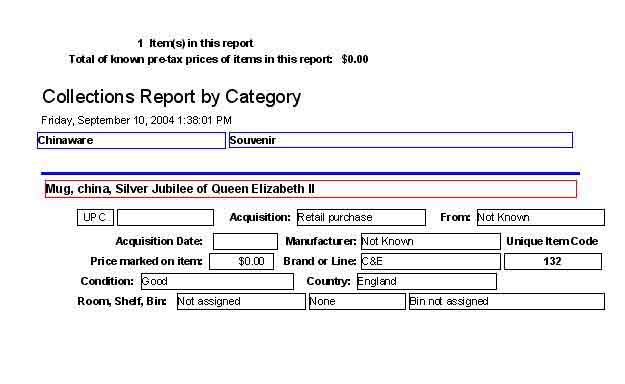The mug is now being added to the Collection. Commencing with this plate, we present the recommended step-by-step procedure for adding an item to the Collection.
--more--

It is important to note that the index defines the collection. That is, if an item is not indexed in the Collections Database, it cannot be considered to be part of the Collection. Therefore, we have indexed our Silver Jubilee mug as item number 132 (see accompanying illustration showing the database report).
"But this is absurd!" exclaimed the Collector to the Master of Indexing, as the two gentlemen were waiting for luncheon to be served at the Ratiocinators Club, of which the Master of Indexing is a director. "Surely this item, the Queen's Silver Jubilee Mug, which I recently found in the attic, must be considered to be an authentic part of my collection, even though the mug has not been assigned an index number!"
"That way lies chaos, confusion and disorder," replied the Master of Indexing. "The fact that a collector verbally asserts that an item is a member of a particular collection does not offer cogent evidence that the item indeed belongs to the collection."
"Consider the following illustrative example," continued the Master of Indexing. "Suppose that an eclectic accumulation of furniture from the household of a deceased gentleman is in the process of being auctioned. The auctioneer, who has just sold a valuable Louis Quatorze chair, which has been catalogued as Article Number 55, is about to accept bids on Article Number 56, a glass-topped Art Deco coffee table. Suddenly, a disheveled gentleman appears in the back of the auction hall. He is holding a collapsible plastic-and-canvas lawn-chair over his head.
"He shouts: ' This chair was frequently used by His Majesty King Edward VII while he attended many alfresco luncheons at the estate of my ancestors. Since those Edwardian days, this chair has languished in an attic, sadly neglected after having been put to such Royal use! This valiant chair, its strained hinges and stretched canvas offering mute testimony of the Royal burden which it bore again and again, is clearly a valuable component of this collection, even though it has not been assigned an index number in the auction catalogue. The mustard stain on the padding of the armrest, if analyzed correctly, will prove to be from an obscure, imported German variety much favored by His Majesty!'
"The members of the auction audience turn their heads. A prospective buyer exclaims: ' Rubbish!. Chairs of that style were not manufactured until many decades after the death of King Edward VII. German mustard, indeed! How dare you interrupt this procedure with such patent nonsense?' "
"As the ushers politely escort the importunate gentlemen from the auction hall, the auctioneer explains to the audience: ' Our apologies, ladies and gentlemen. The gentleman who has just departed the hall is the bereaved and distinguished son of the recently deceased former owner of this collection. While we do not wish to impugn his assertion that the chair which he offered is indeed a component of this collection, we also dare not impugn the authority of our catalogue, which was compiled with the greatest attention to completeness and detail.' "
The Master of Indexing paused, awaiting the Collector's reaction .
"I follow your reasoning," said the Collector to the Master of Indexing. "The latest edition of any collection's indexed catalogue must be the current arbiter of authenticity of said collection."
"Precisely my point," said the Master of Indexing. "The index must always define the collection, and the collection must always be defined by the index. If an article is introduced as a presumptive component of a collection, it must, perforce, be offered for entry into the index before any claim of authenticity can be adduced."
At this time, the colloquy was interrupted by the waiter at the Ratiocinators Club, who had just wheeled up a serving cart with the Collector's order of Thinly Sliced Tongue with Hollandaise and Poached Mushrooms, and the Master of Indexing's order of Hamburg Steak a l'Americain with Pommes du Terre McDonald.
Go to top of page